|
Read 13065825 times
Connect me to:
|
KumquatsFruits, Desserts, and Other Sweet Foods
Spring Volume: 2010 Issue: 17(1) page(s): 11, 12, 13, and 26
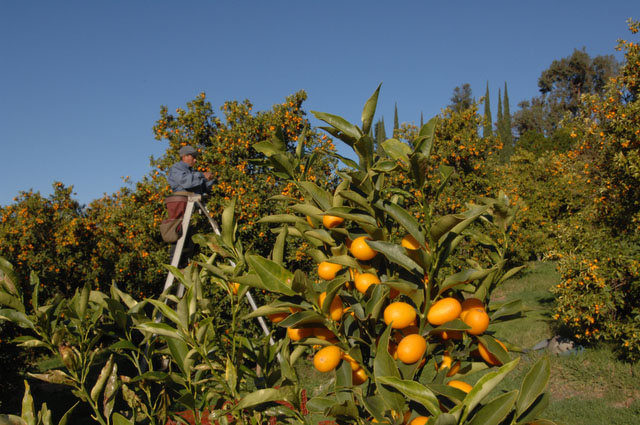 A Little Respect for Kumquats, please. This perplexing sweet-tart fruit – and yes, you eat the rind too – is finding favor with cooks and specialty growers alike. A Little Respect for Kumquats, please. This perplexing sweet-tart fruit – and yes, you eat the rind too – is finding favor with cooks and specialty growers alike.
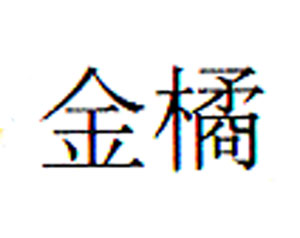 Growing up in Los Angeles in the 1960s, my brother and I knew just what to do with kumquats from the potted tree on the patio: We tossed them at each other. Like most Californians then, we never ate them. Growing up in Los Angeles in the 1960s, my brother and I knew just what to do with kumquats from the potted tree on the patio: We tossed them at each other. Like most Californians then, we never ate them.
Kumquats do present a challenge for the uninitiated. In most citrus, the juicy pulp is consumed and the peel discarded. Kumquats, however, do not follow this pattern. They are eaten whole; their appeal stems from the contrast between their tart flesh and thick, sweet rind. But maybe folks are finally catching on. Without much fanfare, more and more kumquats are being grown in California, which now leads the nation in production. Granted, it is still a minor crop compared to other citrus, but chefs and home cooks alike are giving kumquats more respect, and specialty growers are planting intriguing, previously rare varieties. 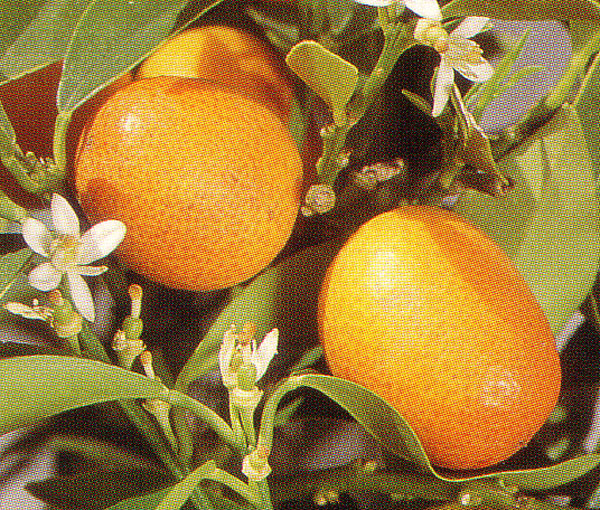 Kumquats are intense, complex flavor bombs. Trained sensory analysts detect a fresh, citrusy odor and pungent taste to begin, followed by green and woody notes, with a persistent oily undertone and a sweet, apricot-like aftertaste. A few years ago, a Korean flavor chemist determined that the component that imparts the fruit's distinctive spicy aroma is an ester, present in minute quantities and called citronellyl acetate. Kumquats are intense, complex flavor bombs. Trained sensory analysts detect a fresh, citrusy odor and pungent taste to begin, followed by green and woody notes, with a persistent oily undertone and a sweet, apricot-like aftertaste. A few years ago, a Korean flavor chemist determined that the component that imparts the fruit's distinctive spicy aroma is an ester, present in minute quantities and called citronellyl acetate.
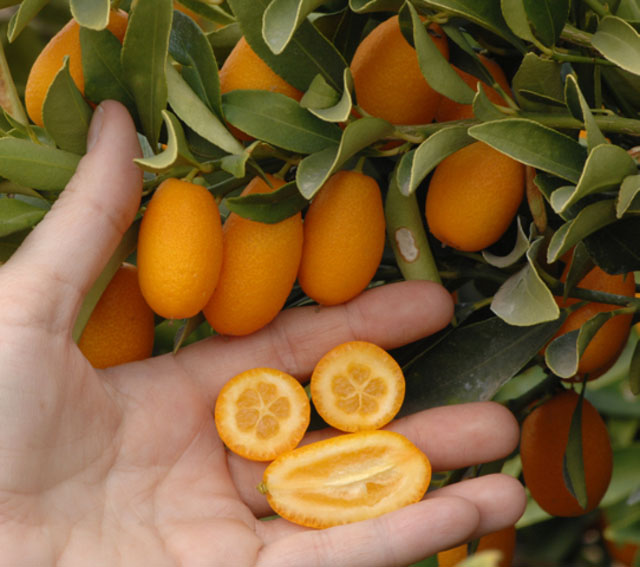 Northern San Diego County, where many farms focus on specialty crops, is the nation's top production area, with seventy-one acres of kumquats, mostly in small plantings. The local season starts in January and runs through June, but kumquats are at their best, fully ripe yet still firm, from February through April. Northern San Diego County, where many farms focus on specialty crops, is the nation's top production area, with seventy-one acres of kumquats, mostly in small plantings. The local season starts in January and runs through June, but kumquats are at their best, fully ripe yet still firm, from February through April.
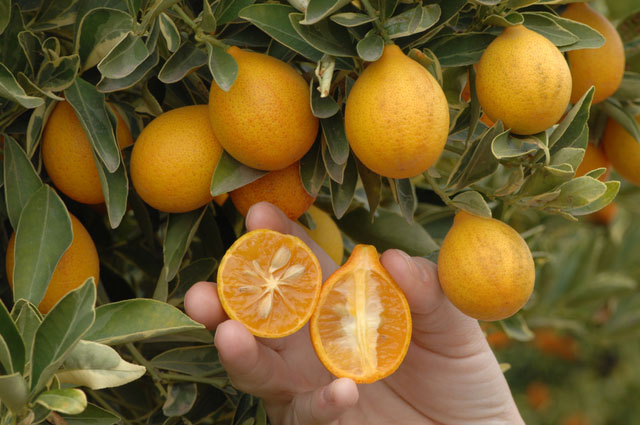 The fruit's biggest booster may be Helene Beck of Fallbrook, a.k.a. 'Miss Kumquat.' She grows several hundred of the trees with her husband, Robert. They sell them wholesale and online, along with kumquat syrup, purée, conserves and fruit leather, and she is working on a book of recipes. "Even here in Fallbrook, many people still don't know what to do with them," she says, offering a plate of freshly baked kumquat cookies. The fruit's biggest booster may be Helene Beck of Fallbrook, a.k.a. 'Miss Kumquat.' She grows several hundred of the trees with her husband, Robert. They sell them wholesale and online, along with kumquat syrup, purée, conserves and fruit leather, and she is working on a book of recipes. "Even here in Fallbrook, many people still don't know what to do with them," she says, offering a plate of freshly baked kumquat cookies.
The view from her Tuscan-style hilltop villa, flanked by cypress trees, evokes an old-world vineyard and chateau. Below in the kumquat orchard, the lush green trees sparkle with bright orange fruit, which two workers painstakingly clip into canvas sacks. Chefs prize kumquats' pungency, chewy texture and sheer beauty. Breanne Varela, pastry chef at Lucques and AOC, is planning a dessert of yogurt panna cotta served with candied kumquats, cocktail grapefruit and blood oranges. Zoe Nathan at Rustic Canyon combines kumquats with crème fraîche for an ice cream that she serves by itself or with cornmeal pound cake. Kumquats are native to China, where they are eaten fresh, made into preserves, used for religious offerings and grown as ornamental plants. They are popularly considered citrus, and were classified as members of the Citrus genus after the Scottish botanist Robert Fortune brought the first kumquat plant to Europe in 1846. But in 1915, the great scientist Walter T. Swingle established a new genus, Fortunella, for kumquats, based on structural differences in their flowers, leaves and fruits, compared with those of other Citrus. Molecular sequence analyses, which in theory could determine how close kumquats are to Citru |

 A Little Respect for Kumquats, please. This perplexing sweet-tart fruit – and yes, you eat the rind too – is finding favor with cooks and specialty growers alike.
A Little Respect for Kumquats, please. This perplexing sweet-tart fruit – and yes, you eat the rind too – is finding favor with cooks and specialty growers alike.  Growing up in Los Angeles in the 1960s, my brother and I knew just what to do with kumquats from the potted tree on the patio: We tossed them at each other. Like most Californians then, we never ate them.
Growing up in Los Angeles in the 1960s, my brother and I knew just what to do with kumquats from the potted tree on the patio: We tossed them at each other. Like most Californians then, we never ate them.  Kumquats are intense, complex flavor bombs. Trained sensory analysts detect a fresh, citrusy odor and pungent taste to begin, followed by green and woody notes, with a persistent oily undertone and a sweet, apricot-like aftertaste. A few years ago, a Korean flavor chemist determined that the component that imparts the fruit's distinctive spicy aroma is an ester, present in minute quantities and called citronellyl acetate.
Kumquats are intense, complex flavor bombs. Trained sensory analysts detect a fresh, citrusy odor and pungent taste to begin, followed by green and woody notes, with a persistent oily undertone and a sweet, apricot-like aftertaste. A few years ago, a Korean flavor chemist determined that the component that imparts the fruit's distinctive spicy aroma is an ester, present in minute quantities and called citronellyl acetate.  Northern San Diego County, where many farms focus on specialty crops, is the nation's top production area, with seventy-one acres of kumquats, mostly in small plantings. The local season starts in January and runs through June, but kumquats are at their best, fully ripe yet still firm, from February through April.
Northern San Diego County, where many farms focus on specialty crops, is the nation's top production area, with seventy-one acres of kumquats, mostly in small plantings. The local season starts in January and runs through June, but kumquats are at their best, fully ripe yet still firm, from February through April.  The fruit's biggest booster may be Helene Beck of Fallbrook, a.k.a. 'Miss Kumquat.' She grows several hundred of the trees with her husband, Robert. They sell them wholesale and online, along with kumquat syrup, purée, conserves and fruit leather, and she is working on a book of recipes. "Even here in Fallbrook, many people still don't know what to do with them," she says, offering a plate of freshly baked kumquat cookies.
The fruit's biggest booster may be Helene Beck of Fallbrook, a.k.a. 'Miss Kumquat.' She grows several hundred of the trees with her husband, Robert. They sell them wholesale and online, along with kumquat syrup, purée, conserves and fruit leather, and she is working on a book of recipes. "Even here in Fallbrook, many people still don't know what to do with them," she says, offering a plate of freshly baked kumquat cookies. 